Zilucoplan: An Investigational Complement C5 Inhibitor for the Treatment of Acetylcholine Receptor Autoantibody–Positive Generalized Myasthenia Gravis
Howard, James F.; Vissing, John; Gilhus, Nils Erik; Leite, Maria Isabel; Utsugisawa, Kimiaki; Duda, Petra W.; Farzaneh-Far, Ramin; Murai, Hiroyuki; Wiendl, Heinz
Journal article, Peer reviewed
Published version

Åpne
Permanent lenke
https://hdl.handle.net/11250/2770699Utgivelsesdato
2021Metadata
Vis full innførselSamlinger
- Department of Clinical Medicine [2066]
- Registrations from Cristin [9791]
Originalversjon
Expert Opinion on Investigational Drugs. 2021, 30 (5), 483-493. 10.1080/13543784.2021.1897567Sammendrag
Generalized myasthenia gravis (gMG) is an autoimmune disorder in which pathogenic autoantibodies damage the neuromuscular junction, causing disabling or life-threatening muscle weakness. Most treatments nonspecifically inhibit aspects of the immune system, do not directly address the causal mechanisms of tissue damage, and often have side-effect profiles that negatively impact patients. Understanding of the central pathogenic role of the complement cascade in gMG is advancing, and a new complement-targeting treatment is under investigation.
Areas covered
We provide an overview of gMG etiology, the complement cascade, current treatments, and the investigational gMG therapy zilucoplan. Zilucoplan is a small, subcutaneously administered, macrocyclic peptide that inhibits cleavage of complement component C5 and the subsequent formation of the membrane attack complex.
Expert opinion
In a randomized, double-blind, placebo-controlled, phase 2 clinical trial, zilucoplan demonstrated clinically meaningful complement inhibition in patients with acetylcholine receptor-positive gMG. Zilucoplan, a first-of-its-kind cyclic peptide targeting C5, appears to be a therapeutic option for the treatment of gMG based on available pharmacokinetic/pharmacodynamic data and phase 1 and 2 efficacy, safety, and tolerability data with limited long-term follow-up. Zilucoplan use earlier in the treatment paradigm would be suitable in this population should phase 3 efficacy and safety data be equally favorable.
